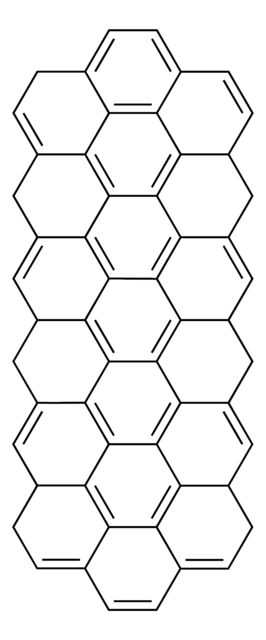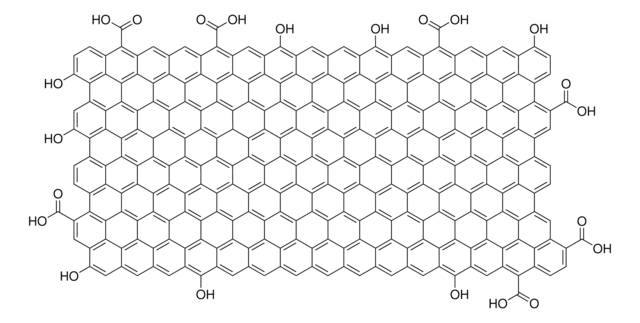797774
Graphene nanoribbons
About This Item
Prodotti consigliati
Saggio
≥90.0% carbon basis (TGA)
Stato
powder
Lungh. × largh.
2-15 μm × 40-250 nm
Densità
2.2745 g/mL (He gas method)
Densità bulk
0.0970 g/mL (Mercury Porosimetry)
Cerchi prodotti simili? Visita Guida al confronto tra prodotti
Descrizione generale
Applicazioni
- Composites.
- Conductive inks.
- Electrodes for LiB.
- Energy storage & harvesting applications.
- Bio-medical applications.
- Preferred dispersing organic solvents: pyrrolidones and chlorinated solvents.
- Less preferred dispersing organic solvents: cyclohexanone and γ-butyrolactone.
- Aqueous dispersions are possible at 0.1mg/mL with triton-X-100, sodium cholate and deoxycholate and cellulose-based surfactants.
Risultati analitici
ID/IG = 0.65±0.07
I2D/IG = 0.74±0.03
2D FWHM = 63 cm-1
Note legali
Avvertenze
Danger
Indicazioni di pericolo
Consigli di prudenza
Classi di pericolo
Carc. 2 - Repr. 2 - STOT RE 1 Inhalation
Organi bersaglio
Lungs
Codice della classe di stoccaggio
6.1C - Combustible acute toxic Cat.3 / toxic compounds or compounds which causing chronic effects
Classe di pericolosità dell'acqua (WGK)
nwg
Scegli una delle versioni più recenti:
Certificati d'analisi (COA)
Non trovi la versione di tuo interesse?
Se hai bisogno di una versione specifica, puoi cercare il certificato tramite il numero di lotto.
Possiedi già questo prodotto?
I documenti relativi ai prodotti acquistati recentemente sono disponibili nell’Archivio dei documenti.
Articoli
Graphene is a unique two-dimensional (2D) structure of monolayer carbon atoms packed into a dense honeycomb crystal that has attracted great interest due to its diverse and fascinating properties.
Since its discovery little more than a decade ago,1 the two-dimensional (2D) allotrope of carbon—graphene—has been the subject of intense multidisciplinary research efforts.
Graphene's unique properties spark interdisciplinary interest; its honeycomb structure offers electrical, optical, and mechanical marvels.
Graphene nanoribbons (GNRs) are quasi-one-dimensional narrow strips of graphene comprised of sp2-hybridized carbon atoms arranged into hexagonal honeycomb lattice configurations.
Il team dei nostri ricercatori vanta grande esperienza in tutte le aree della ricerca quali Life Science, scienza dei materiali, sintesi chimica, cromatografia, discipline analitiche, ecc..
Contatta l'Assistenza Tecnica.







